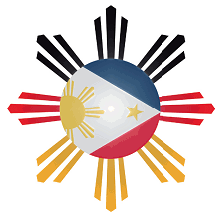ZitatAlles anzeigen
Who Were The First Filipinos? A View About the Culture and Origins of the Filipinos
von Allen Severino
Before I can start this article, I shall ask you a question. When did we began to call ourselves as Filipinos in the first place? Was it during the Pre Hispanic era? Did Lapu- Lapu considered himself a Filipino? No. Was it during the Spanish era? No,, because the term Filipino was reserved to Creoles (Kastilaloys in the modern sense) and the rest were classified to Mestizos, Sangleys, foreigners and Indios. Our history tends to portray that the Philippines was a conquered civilisation. So, there are many theories regarding who are the first people who inhabited the islands called the Philippines. Remember, before the Spanish occupation, there was no concept of a unified nation and even a name called the Philippines.
Before I will begin to explain these theories and the origins, I will begin it by explaining that the concept of a nation did not existed until the 19th century, during the time of the French Revolution. It was a new era, where the concepts of nationalism, democracy and even socialism were born out of the ashes of the old order, namely the aristocracy and the clergy.
The concept of race has been already debunked by the Human Genome Project. Race has been defined as an excuse made by supremacists to justify slavery and a false sense of superiority. The concept of state did not existed until the Peace of Westphalia in 1648, where for the first time in history, the idea of sovereignty was born. The treaty became also the basis for the constitutional framework of the Holy Roman Empire and international law in general.
Now back to the topic, several of these theories are already encountered in elementary and high school days. The most popular of this theory is the Migration Theory by Otley Beyer. First and foremost, the migration theory is unreliable and oversimplified, it lacks complexity and substance because it tends to simplify the origin of the people in the islands. Beyer used the old 19th century scientific methods of migratory diffusion.
This method has been proven to be unreliable but still I am still asking myself why this theory became a staple to our history textbooks? I believe that evolution is a process that will last hundreds, thousands and even millions of years. An interesting study conducted during 2001 revealed that Haplogroup O3-M122 (labeled as "Haplogroup L" in this study) is the most common Y-chromosome DNA haplogroup found among Filipinos. This particular haplogroup is also predominant among Chinese, Koreans, and Vietnamese. Another haplogroup, Haplogroup O1a M119 (labeled as "Haplogroup H" in this study), is also found among Filipinos. The rates of Haplogroup O1a are highest among the Taiwanese aborigines, and Chamic-speaking people. Genetically, we may be similar to the Asians, but culturally we are very similar to Latin America due to 333 years of Spanish rule.
The first possible people who settled in the Philippines were the Aboriginal people or the pygmies popularly known as the "Negritos". There are two possible theories of their origins. The most popular theory is they came from Central Asia and traveled in groups. Some of these people settled in Malaysia and became the Orang Asli, but the others continued until they reached the Philippines, due to the relatively low sea levels because the world at that time was covered by ice.
That is why we can explain how prehistoric people managed to migrate quickly out of Africa to the other parts of the world, such as the early Native Americans through the Bering land bridge from Siberia. The earliest human remains are not the Tabon Man, but rather the Callao Man, discovered just recently last 2007. It was 20,000 years older than the Tabon Man discovered by Robert J. Fox.
Forstsetzung im neuen Post

